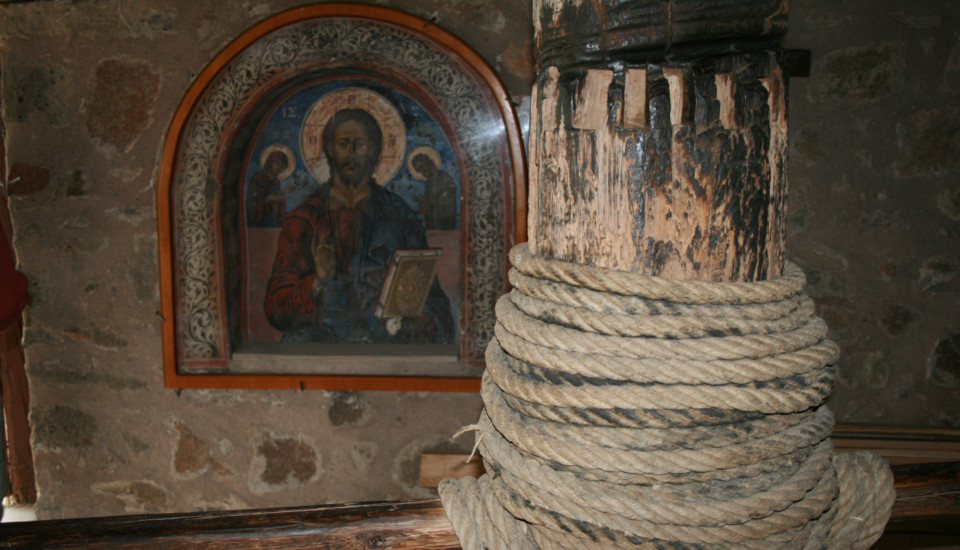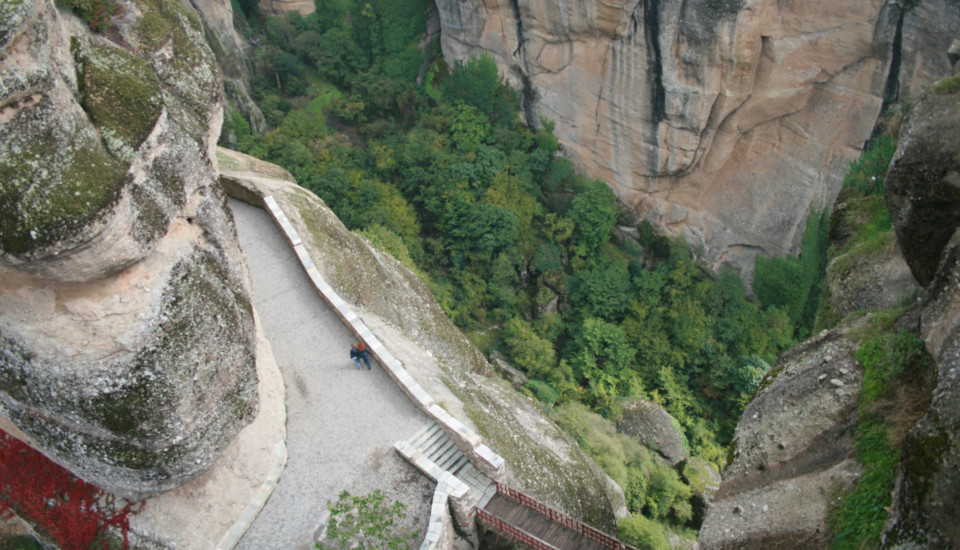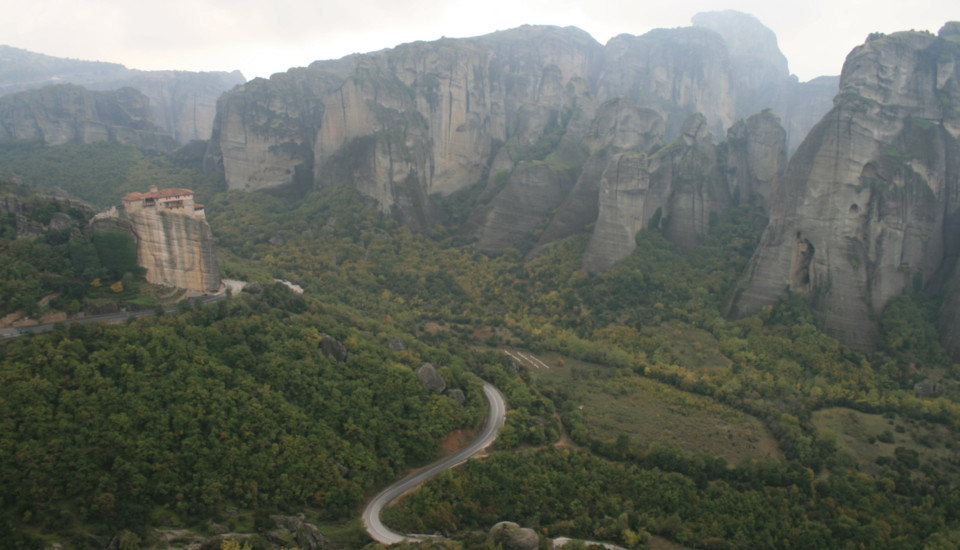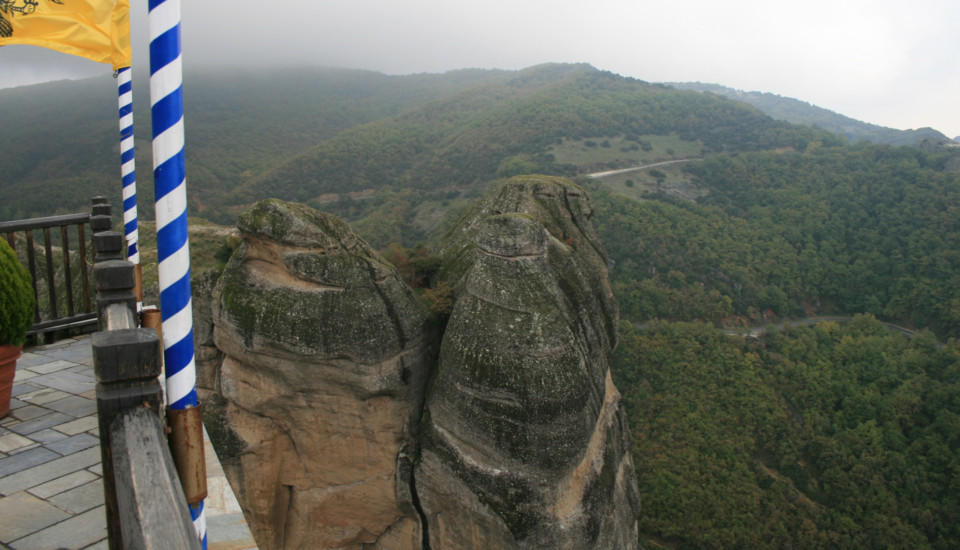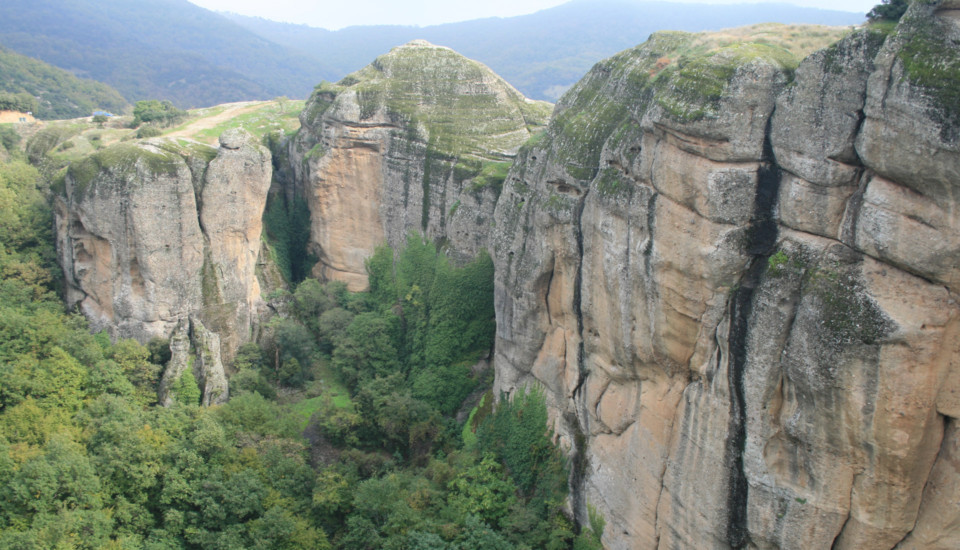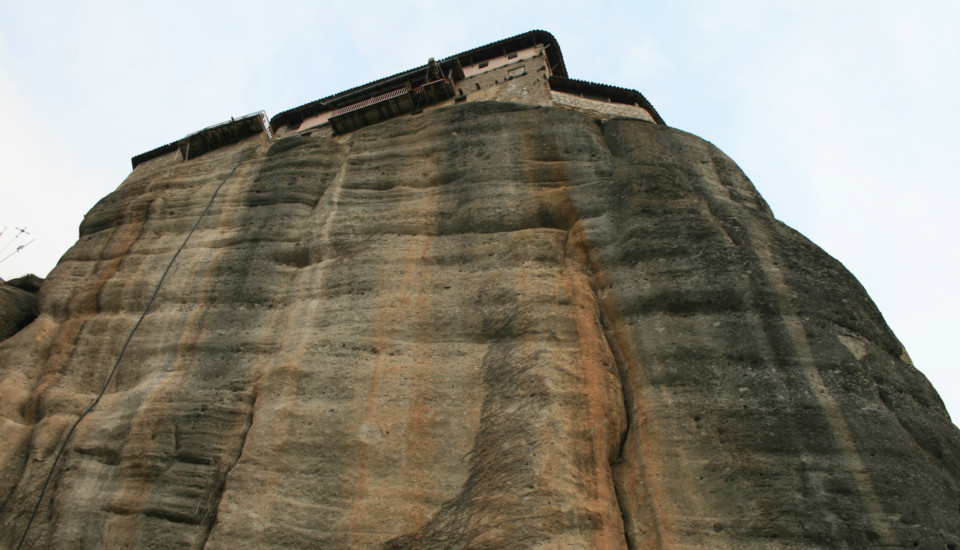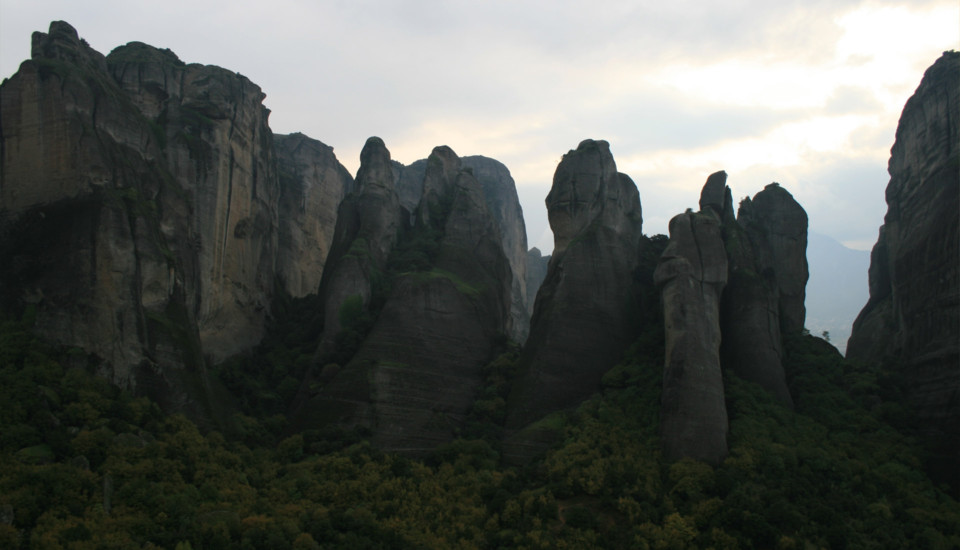"Ainutlaatuisia näytteitä keskiaikaisesta luostariarkkitehtuurista koristavat Meteoran kalliopilarien huippuja. Ensimmäiset luostarit perustettiin 1400-luvulla, kun luostariyhteisöt alkoivat kehittyä. Kaiken kaikkiaan, 24 luostarissa asuttiin viidennen vuoden aikana- 100- ja 1600-luvuilla, vaikka nykyään vain kuusi on edelleen aktiivinen" - Lyratzaki, 2006.
Sivuston kuvaus
Kreikan Thessalian alueen tasangoilla sijaitsi Antichasia-vuoristo, jossa on suuri pyhä luonnonpaikka Meteora. Se on 24 luostarin sarja, jotkut yli kuusisataa vuotta vanhoja, kohoaa maanpinnan yläpuolelle useiden massiivisten kalliopilareiden päällä, jotka ovat muokanneet pitkän altistuksen voimakkaille elementaarisille voimille, mukaan lukien maanjäristykset ja joet. Se on ortodoksisten kristittyjen pyhiinvaellus- ja tunnustuspaikka. Kaikki sen vierailijat eivät ole pyhiinvaeltajia, vaikka. Suuri joukko ihmisiä tulee Meteoraan ihailemaan henkeäsalpaavaa maisemaa, Unescon maailmanperintökohde sekä luonnon- että kulttuuriperintönsä vuoksi. Vaikka turistit tuovat aineellista vaurautta sivustolle, he myös uhkaavat sitä numeroillaan. Silti näyttää olevan toivoa paremmasta.
"Tämän maan sisällä- kunnioitusta herättävien muotojen maisema, volyymit ja tekstuurit, on se harvinainen tunne tuntea itsensä sekä pieneksi että suureksi samanaikaisesti näiden erinomaisten luonnontaideteosten kanssa"
- Lyratzaki, 2006.
Uhat
Matkailu on suurin uhka paikalliselle uskonnolle, kulttuuria ja paikallista ympäristöä. Turistit eivät pelkästään uhkaa suoraan ekosysteemejä autoliikenteellä, melusaaste ja lisääntyneet infrastruktuurin ja jätehuollon tarpeet. Ne tuovat myös kassavirtaa, jolla on negatiivinen vaikutus tiettyjen luostariyhteisöjen askeettiseen elämäntapaan.. Nykytekniikan lisääntyessä hallitsematon torjunta-aineiden ja lannoitteiden käyttö saastuttaa maaperää ja pohjavesiä. Toinen suuri uhka on liikalaiduntaminen, mikä heikentää paikallista luonnollista ekosysteemiä.
Visio
Integroitu ja kokonaisvaltainen hoitosuunnitelma on olennainen luonnon tehokkaimman suojelun kannalta, alueen kulttuurista ja henkistä perintöä. On löydettävä keskitie, jotta paikan pyhyys säilyy sen kehittämisessä. Kaikkien sidosryhmien tulee sopia tästä hoitosuunnitelmasta. Yleisön tietoisuutta on lisättävä, esimerkiksi munkkien ohjaamien vierailukeskusten kautta, tai liikennemerkkien avulla, selittää luonnon ja pyhyyden välisen läheisen yhteyden paikalla. Koulutukset paikallisissa kouluissa ja yrityksissä voisivat tukea tätä. Ottaen huomioon alueen luostariyhteisöjen korkea uskottavuus, tämän tietoisuuden lisääminen olisi tehokkainta, jos uskonnolliset johtajat tekisivät sen.
Toiminta
Eri korkeakoulut ovat tehneet erilaisia tutkimuksia lisätäkseen tietoisuutta alueen ongelmista. Yliopistot järjestävät tutkimuskokouksia ja seminaareja, Maatalouden tutkimus- ja kehitysorganisaatiot. Restaurointityöt auttavat säilyttämään kulttuurimuistomerkkejä.
Politiikka ja laki
Meteora on nimetty erityissuojelualueeksi Euroopan unionin luonnonvaraisten lintujen suojeludirektiivin mukaisesti.. Se on myös listattu Natura-luetteloon 2000 Se on Unescon maailmanperintökohde luonnon- ja kulttuuriarvojensa vuoksi. Lisäksi, se on julistettu pyhäksi, Pyhä ja muuttumaton paikka lain kanssa 2351/1995, muistomerkkien ja perintöjen suojelemiseksi, ja suojellakseen heidän henkistä luonnettaan. Alueen pääviranomaiset ovat paikallisten kaupunkien kunnat, luostariyhteisö ja Bysantin antiikin seitsemäs eforaatti, osana Kreikan kulttuuriministeriötä.
Ecology & Biodiversiteetti
Alue on kukkuloiden mosaiikki, vuoret, kiviä ja luolia. Tammimetsän kukkulat, joen tasometsät ja ympäröivät laitumet tarjoavat elinympäristöjä 163 kirjattuja lintulajeja, joista kymmenen on suojattuja. Niissä on myös erilaisia nisäkäslajeja, mukaan lukien punainen kettu (Kettu kettuja), Euroopan susi (Canis lupus) ja Pieni hevoskenkälepakko (Rhinolophus hipposideros). Esiintyy useita endeemisiä kukkalajeja, joiden joukossa uhatut Centaurea kalambakensis ja Centaurea chrysocephala.
Huoltajat
Tänään, paikalla on jäljellä vain kuusi luostariyhteisöä. Meteoran munkkien elämää leimaa alueen kulttuuriset ja henkiset arvot, ja heidän elämäntapansa leviää naapurikyliin. Vaikka suuri osa heidän käsityksistään on ortodokseja, suurinta osaa heidän normeistaan ja arvoistaan kunnioitetaan ja suuri yleisö ymmärtää, taustastaan riippumatta. Suuri osa paikallisten ihmisten tuloista riippuu turisteista, joille he välittävät näitä arvoja. Kun munkit järjestävät opastettuja kierroksia, joiden kautta he kiinnittävät vierailijoiden huomion Meteoran henkisiin ominaisuuksiin, he huomaavat muutoksen vierailijoiden käsityksissä sivustosta, vastoin matkailuoppaiden antamia vakiomatkoja, josta sivuston henkinen ulottuvuus yleensä puuttuu. Munkit valmistavat perinteisesti erilaisia käsityöläisiä ja kalligrafisia esineitä. Erakot asuvat edelleen useissa paikallisissa luolissa. Pakanallista alkuperää olevat tavat ovat olleet lannistaneet vuosien ajan, kuitenkin monet paikalliset juhlat jatkuvat vuodenaikojen mukaan.
Koalitio
Toistaiseksi, paikalla ei ole yhtä ainoaa ympäristönsuojelusta vastaavaa tahoa. Metsähallitus, ympäristöministeriön osasto, Energia ja ilmastonmuutos, johtaa alueen yleistä hallintoa, kun taas kallioita suojelee arkeologinen palvelu. Luostariyhteisö on kiinnostunut ympäristönsuojelusta, ja tekee kaikkensa suojellakseen luonnonarvojaan. Ympäristönsuojeluun ei ole toistaiseksi kohdistunut yhtenäisiä liikkeitä. Maatalouden tutkimuslaitoksen ympäristötutkimuksessa neuvottiin perustamaan keskushallintoelin. Sitä ei valitettavasti ole toteutettu finanssikriisin vuoksi.
Conservation työkalut
Paikallisen ympäristön suojelun keskeiset työkalut ovat joukko osapuolten tarjoamia rajoituksia. Pylväiden ympärillä rakentaminen on ehdottomasti kielletty ja läheisessä Kastrakin kylässä, jota luonnehditaan perinteiseksi asutukseksi, sitä säännellään. Siitä lähtien, kun paikka on julistettu pyhäksi, riippuliito ja kalliokiipeily on rajoitettu tiettyihin kallioihin.
Itse monumentit kunnostetaan rakennusten peruskorjauksella ja niiden arvokkaita elementtejä konservoimalla. Luostariyhteisö säätelee henkistä matkailua ylläpitämällä aikataulua, jonka mukaan vierailijat voivat kuulla munkkeja ja päästä luostareihin.
Tulokset
Meteoran julistaminen suojelluksi luonnon- ja kulttuurikohteeksi on ollut tärkeä ensimmäinen tulos taistelussa sen suojelusta.. Prosessissa, useat laitokset ovat julkaisseet useita tieteellisiä raportteja alueen tutkimuksista, Asukkaat munkit noudattavat tarkasti suosituksia, jotka tekevät parhaansa suojellakseen aluetta. He kokevat myös, että heidän pyrkimyksensä esitellä kulttuurisesti suuntautuneita turisteja alueen henkisissä osissa auttaa monia näkemään sen pyhänä muistomerkkinä.. Silti tietoisuutta on lisätty onnistuneesti, tarvitaan suurempia ponnisteluja tämän yhteisön pitämiseksi pyhänä sellaisena kuin se on.
"Menneisyydessä, luolat olivat – ja jotkut ovat edelleen – paikkoja, joissa erakot asuivat, kun taas luostarit rakennettiin valtavien kallionhuippujen päälle. Lisäksi, monet paikalliset tavat liittyvät vuodenaikojen vaihtumiseen ja itse luontoäitiin" - Lyratzaki, 2006.
- Lyratzaki I (2006) Meteoran maailmanperintökohde. Thessalia, Kreikka. Ja: Mallarach JM ja Papayannis T (toim.). Suojelualueet ja hengellisyys. Proceedings of ensimmäisen työpaja Delos Initiative - Montserrat. PAM julkaisut. Montserrat.
- Meteora – Unescon maailmanperintökohde: http://whc.unesco.org/en/list/455
- Irini Lyratsaki, Delos Initiativen ohjelmavastaava


